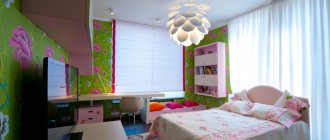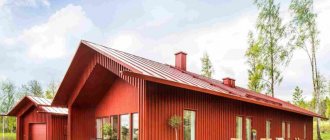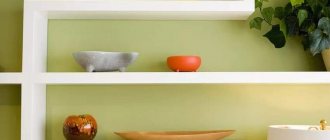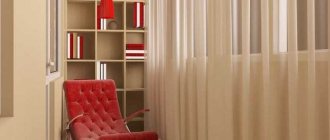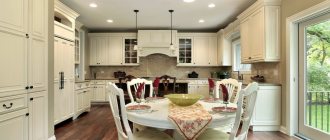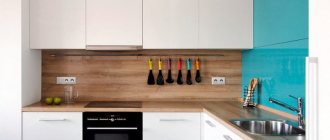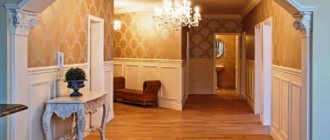What types of ceilings are there by design?
From a structural point of view, a modern ceiling is a specific system, including a frame and finishing. However, there are other options.
A simple ceiling is the standard, which involves only surface finishing. As a rule, it also includes at least 2 layers. The surface is first plastered to level it, then puttyed to achieve perfect smoothness. Then they proceed to the finishing itself: whitewashing, painting, wallpapering or even tiling.
Important! Decorative plaster replaces any other finishing method.
Hemming is a more complex option. A lathing, usually wooden, is attached to the prepared ceiling surface. Then the finishing material is fixed to the slats: lining, sheets of drywall, slats. This type of ceiling reduces the height of the room by no more than 5–8 cm. In this case, you can install overhead spotlights. A voluminous communication, like a hood, cannot be hidden by a hemmed appearance.
Suspended structures are a more complex type. It got its name from its frame base. Unlike conventional sheathing, the elements to which the trim will be attached are installed on various types of hangers. They can be adjusted in height. Depending on the chosen system, the suspended ceiling can be located at different distances from the base ceiling surface, which will allow you to hide any pipes and hoods, as well as install any complex lighting. But at the same time, the height of the room is reduced accordingly - by at least 15 cm.
There are several types of this design:
- modular - the visible plane consists of elements: plates, slats, cassettes, panels; the frame is hidden or used as a design element - in Armstrong ceilings; installation of a modular system is simpler, as it assumes uniformity - slats or slabs of the same size and shape;
- solid - in these types of ceilings the surface after finishing is solid, this result is obtained by covering the frame with plasterboard, installation of solid ceilings is more difficult due to the design diversity - the plasterboard sheet is quite thin, it is easy to bend and cut to size, the material allows you to form a multi-level ceiling of the most complex configuration with three-dimensional figures of different shapes.
Stretch ceilings - this version of ceilings in an apartment differs in both the installation method and the method of fastening. Tension fabric - polyvinyl chloride film or special fabric is fixed to the wall using special baguettes. In this case, the condition of the base surface and the number of laid pipes do not matter at all, since baguettes can be fixed at any distance. Stretch ceilings are extremely decorative and varied, and installation takes no more than 4 hours. However, attaching the film is only possible with the use of special equipment.
Experience shows that both in apartments and in private houses, suspended solid ceilings and suspended ceilings are increasingly preferred. Despite their high cost, they are more functional, decorative and last much longer.
Multi-level ceilings
To create such a design, it is possible to use any finishing materials or use several finishing options in combination. A common type of ceiling is a plasterboard ceiling with inserts of tension fabrics or mirror panels. Additionally, the surface is decorated with wallpaper, decorative plaster, artistic painting or gypsum stucco.
A multi-level ceiling will highlight the features of each room, hide floor defects, and divide the space into functional zones.
The design of a multi-level ceiling can be different: in the form of regular geometric shapes, cones, waves, curved lines, etc. Moreover, the number of levels is limited only by the height of the room being finished.
Any lighting devices will fit into the design - spotlights, LED strip, flat lamps, traditional chandeliers, etc. Thanks to this, you can create basic and additional lighting, highlight individual areas, decorative elements and accessories in the room.
Thus, there are many options for how to decorate the ceilings. Before choosing, carefully consider the concept of your future interior, calculate your budget and purchase quality materials. As for installation, you can entrust it to professional craftsmen, or try to implement the idea yourself. On our website you will find instructions on different methods of decorating ceilings that will help you in your work.
Which ceiling to choose based on material
The finishing of the ceiling surface is no less varied than the design of the system itself. This allows you to select optimal solutions for rooms with any operating conditions and at the same time not lose anything in either decorativeness or practicality.
The basis of a simple option is a concrete ceiling slab. The primary finishing materials are plaster and putty. This is a plastic building mass that allows you to level the surface and give it an attractive appearance if decorative material is used. In addition, plaster allows and absorbs moisture, that is, it is a vapor-permeable material and is quite resistant to mold if you first use an antiseptic primer.
The plaster can be additionally finished in a variety of ways: whitewashed, covered with liquid wallpaper, covered with polyurethane foam tiles.
In hemmed types of construction, the material used is more voluminous. This can be lining, plastic panels imitating stone, wood, or a mirror surface. Drywall and polyurethane boards are also used. In these types of designs, it is difficult to separate the construction material and the finish, since one layer performs both functions.
Important! The strength of a suspended structure is much lower than that of a suspended structure. For this type of ceiling, you cannot use heavy materials: glass or mirror slabs.
In addition, in this case it is impossible to organize lighting, and without this, glass slabs lose half their attractiveness.
Suspension systems offer the greatest scope for imagination:
- plasterboard - these types of ceilings are the most popular, the cost of a plasterboard sheet is very affordable, and its flexibility and ease of installation allows you to create the most decorative options;
- metal slats - more often used in public institutions and private houses, as they allow the installation of complex ventilation systems; in apartments, slatted structures are installed in bathrooms, toilets, and kitchens, where there is high humidity and temperature changes; aluminum and steel slats are unusually strong, durable, and do not corrode; these types of ceilings are indispensable in glamorous styles: baroque, art deco, hi-tech;
- Armstrong system - the frame in this case is visible and is a design element, however, the main material is slabs; the choice is huge: cellulose, which has excellent sound-absorbing properties, wood fiber, pressed mineral fibers, fiberglass, glass and mirror.
Tensile structures also involve several types of ceilings:
- tension film - a thin polyvinyl chloride film, its strength is low, but it has absolute moisture resistance, is insensitive to evaporation and can easily withstand leakage from above, the decorative nature of the tension film exceeds all imagination; the film can be of different colors and textures - from matte or velvety to glossy or pearl, it can contain a variety of ornaments and images, even reproducing paintings by Renaissance masters, a pattern on the canvas can create a holographic three-dimensional effect, and the film itself can also be given volume;
- fabric canvas - this type of ceiling is less resistant to moisture, so it is suitable for installation only in dry rooms, but they are not afraid of the cold and are much stronger, the decorative capabilities of fabric canvases are noticeably lower, the advantage of this solution is the ability to produce a single piece of large-sized fabric.
A stretch ceiling does not require any additional finishing. Hanging structures can be further decorated and modified.
Which ceiling is better by type of fastening?
Types of ceilings are classified according to the method of installation. The different material and condition of the original ceiling surface limits the choice of fastening.
The hemmed version is fixed rigidly using self-tapping screws. However, a wooden or profile frame weighs little, and the finishing materials for this type of ceiling are also lightweight. Accordingly, hemming trim can be installed even on a plank surface in a wooden house.
Important! The sheathing does not compensate for height differences. This option is only possible if the base ceiling is relatively flat.
A suspended structure involves mounting the frame to the ceiling using hangers. Conventional non-adjustable models are used. They are attached to the base with self-tapping screws on a wooden ceiling or screws with plastic dowels on a concrete one.
In Armstrong-type systems or suspended slatted ceilings, spring suspensions are preferable. The frame in this case is relatively free and allows you to accurately adjust the height and center the ceiling plane.
All types of stretch fabrics are mounted on the wall, not on the ceiling. In this case, a special profile is used - a baguette, into which the film or fabric is fixed after tension. There are 3 fastening methods.
Harpoon - special hooks are attached to the canvas around the perimeter. During installation, the hooks are inserted into the aluminum profile and the canvas is fixed. The method is extremely reliable. In addition, the harpoon installation method allows, if necessary, to partially or completely dismantle the structure and reinstall it. The downside is that there is a gap between the canvas and the wall that needs to be masked.
Beading - the canvas is inserted into the profile using a wedge. In this case, a very narrow baguette is used, and the canvas is firmly fixed. This type of installation is simpler, and the cost of the system is lower. However, it is no longer possible to dismantle the structure and reinstall it. If there is a real risk of leaks from a neighbor above, the harpoon fastening method is preferable.
Clip-on is an option for fabric stretch ceilings. The clip securely fixes the fabric, but does not provide strong tension. The advantage of the system is the absence of gaps between the canvas and the wall.
The fastening method is not actually chosen. Having decided on the type of ceiling, you need to “come to terms” with the method of fixation.
Stretch fabric ceilings
This option is less common. This is largely due to their higher price compared to PVC film ceilings. The installation process is similar to the installation of film ceilings. The only difference is that the room air does not need to be heated. A smooth surface is achieved due to tension when attaching to profiles.
The advantages of fabric ceilings include:
- environmental friendliness, which allows them to be used without fear in children’s rooms and bedrooms;
- are not afraid of low temperatures, so such ceilings can be installed in the country;
- the fabric is stronger than the film, so the ceiling is more difficult to damage;
- quick installation;
- Photo printing available;
- can be used in conjunction with built-in light sources.
There are also disadvantages:
- do not tolerate contact with moisture well, which can cause them to change color and mold to appear on the fabric;
- they also steal the height of the ceilings;
- dismantling and re-installation is problematic;
- higher price.
What types of ceiling finishes are there?
Stretch ceilings or suspended slatted ceilings do not require additional cladding. But other types are more “democratic”. Depending on the strength of the structure and its technical indicators, the following techniques are used for finishing:
- wallpapering, as well as painting, is used to decorate plasterboard structures of any type and complexity;
- lightweight plastic tiles can be installed either on the sheathing of a false ceiling or fixed on the surface of plasterboard sheets;
- tiles are much heavier, but in certain cases it is also possible to glue them onto drywall; it is recommended to use a sheet intended for walls for finishing - it is thicker and stronger;
- cork covering is an interesting option for false ceilings; the material is very light, has excellent noise-proofing qualities, is breathable, but completely impervious to moisture and mold, as it is coated with a thin layer of wax.
Additional finishing is selected taking into account the design of the premises and its color scheme.
Simple types of ceilings mounted and applied directly to the base
Of course, everyone knows the traditional finishing methods: painting ceilings, whitewashing and wallpapering. Let's consider the technology of these finishing works.
Whitewashing the ceiling
The oldest method, gradually losing its popularity, is considered to be a method of simply whitewashing the ceiling. Execution method: using a spray bottle or brush, apply a solution of lime or chalk to the ceiling. To give a beautiful shade, various dyes are added to the solution.
An undoubted advantage is the simplicity of the technology.
Disadvantages: it is difficult to wash off old lime, increased soiling during finishing work, high labor intensity. You cannot do without preliminary preparation: the surface of the ceiling must be perfectly smooth and clean.
Which ceiling is better to design?
The decorative effect of the ceiling is far from a secondary issue. Modern interiors use the ceiling as an active design element. The capabilities of different species models are different, which should be taken into account.
Factors determining the choice:
- style of the room - the concept determines the color scheme, the nature of the material used, and the design; in a loft-style room, a stretched canvas depicting flowers will be out of place, and the best option is to leave the concrete ceiling unfinished and varnish it; in the classical style, baroque or art deco, it is best to install a two- or three-level ceiling, combining plasterboard structures and tension fabric; the color scheme is modest, but involves the use of glossy fabrics and shiny moldings;
- purpose - in some cases it really only serves as a background; you can get by with a hemmed plasterboard structure, painted or covered with wallpaper; in the Scandinavian style, only smoothness and whiteness are required of the surface; in modern or high-tech, the ceiling is a structuring element and can be very decorative; in such cases, a tension fabric is a fail-safe option;
- purpose of the room - when choosing a decorative option, you also have to take into account the functional features, the film canvas perfectly tolerates moisture, so it is suitable for any room, and this type of ceiling such as the Armstrong system with cellulose boards is suitable only for dry, well-ventilated rooms;
- the visual height of the room is an important design task; the right design reduces the physical height of the room, but creates visual space and structure;
- fundamental decorativeness - if we compare the capabilities of different types of ceilings, then the maximum in terms of image and texture is the film version, but in terms of spatial structure, plasterboard multi-level structures are in the lead, with lath systems in second place.
Important! The main factor determining the choice remains personal taste and preference.
What ceilings are best for an apartment?
The apartment includes several rooms with different operating conditions. Accordingly, in one home there may be several types of ceilings or a certain universal option. In this case, not only decorative, but also technical characteristics are taken into account.
There are many possible solutions for ceilings in an apartment, but the choice is made taking into account the technical data of the material.
- The physical height of the room. Any option other than the simple one reduces the height by 5 to 35 cm or more. If the height of the room in the apartment is 2.2 m, it is better not to install a multi-level plasterboard ceiling. Tension fabric or some type of hemming is a more acceptable option.
- Moisture resistance – in the bathroom or kitchen, you should choose a type of finish that is resistant to both high humidity and steam. This can be tiles, plastic panels, glossy or satin stretch fabrics.
- Repairability - unfortunately, not a single home is insured against leaks from above or dampness. For an apartment, it is recommended to choose an option that allows renovation. If it is a suspended ceiling, then with a harpoon method of fastening; if it is a modular suspended ceiling, then it is slatted or with fiberglass plates: they are lighter than glass: they easily withstand the action of water.
- Lighting – suspended ceilings allow you to install any lighting fixtures and any lighting. At the same time, the entire complex cable system is hidden. The possibilities of suspended or suspended ceilings are noticeably more modest.
Important! Whatever type of ceiling is chosen, its quality should be assessed: compliance with technical specifications, integrity of coatings, neutrality of odor.
Wallpaper
Finishing ceilings with wallpaper will allow you to quickly and inexpensively update your interior.
To decorate the ceilings choose:
- paper wallpaper will help hide floor defects and will not take up excess space from the room. Cons – will not last long, will require careful surface preparation;
- vinyl and non-woven fabrics have a wide selection of shades and textures. Thanks to the relief structure of some types, wallpaper masks unevenness and defects in the base ceiling. Special compounds are used for gluing canvases;
- textile wallpaper. Linens are made from different types of fabric - cotton, calico, burlap, tapestry, linen. Advantages - decorative properties, disadvantages - short service life and fragility;
- Liquid wallpaper is one of the options for modern finishing of ceilings in apartments. They are easy to apply, harden quickly, and the damaged area can be repaired without replacing the entire coating. Minus - the material is afraid of moisture.
How to hang wallpaper on the ceiling - a step-by-step guide.
What are the types of ceilings in a private house?
In fact, choosing the type of ceiling for a private house is carried out according to the same criteria. However, in your own building you can provide for higher room heights or an unusual structure.
In addition to the options listed, the following solutions are most often implemented in a private home:
- slatted ceilings - if you need moisture-resistant ceilings for a pool or a really large bathtub, this is the best choice, the ceiling is very decorative and allows for volumetric solutions: the slats can be bent, they hold their shape perfectly, so it’s not difficult to form wavy or arched structures;
- cassette - the system is complex and heavy, especially if such a spectacular material is used as stained glass slabs or mirrors; for this design, the base ceiling must be not only high, but also very durable;
- beams - implemented not only in a wooden house, but also in buildings made in the loft, Provence, chalet style; decorative or real beams remain visible, and the space between them is sealed with plasterboard and clapboard.
Such solutions require not only height, but also a large area of premises.
Ceilings made of natural materials
Wooden lining
If the question is how to decorate the ceilings in a wooden house, the best option would be to cover the surface with wooden clapboard.
Advantages:
- creating a favorable microclimate in the room;
- life time;
- environmental friendliness and safety;
- decorative properties;
- heat and sound insulation;
- ease of installation.
Minuses:
- afraid of humidity and sudden temperature fluctuations;
- there is a possibility of damage to the tree by insects.
However, the disadvantages can be easily prevented if the material is treated with special protective compounds before installing the lining. Proper installation will extend the service life of the coating, and the surface of the decorative ceiling can be given the desired shade using stain or varnish.
MDF panels
This material is easy to install, so you can finish it with MDF boards yourself. The panels are attached to a wooden or metal frame base.
Advantages:
- environmental friendliness. The basis of the panels is wood shavings, which are hot pressed during manufacturing. The composition does not contain phenolic compounds and resins, so after installing such a ceiling there will be no specific odor in the room;
- the versatility of the panels allows them to be used for finishing both living rooms and public spaces;
- color spectrum;
- durability.
Minuses:
- low moisture resistance. When wet, the panels swell and lose their original shape;
- Do not use household chemicals in care;
- afraid of fire, flammable.
Laminate
Laminate for finishing ceilings began to be used relatively recently. This coating looks original, and the range of laminate boards includes a variety of shades. The material is simply mounted on a frame made of wooden beams. The laminated surface is not afraid of wet cleaning, but it is better to avoid it in the kitchen and bathroom, since moisture and constant temperature changes will have a detrimental effect on the material.
Which ceiling to choose for a living room
Finishing materials in residential premises are not subject to heavy loads. Accordingly, the choice here is determined by the decorative characteristics and personal preferences of the owner:
- purpose of the room - as a rule, softer colors and textures are used to decorate bedrooms: pearl stretch fabric, two-level plasterboard ceiling painted in a delicate color; more spectacular options are preferable for the hall: glossy fabric, stretch film with a colorful image;
- design tasks are to structure the space, visually increase the height, in such cases the best solution would be a multi-level plasterboard structure, but no less effective is a combination of single-color fragments and patterned ones that create a visual structure;
- nature of the material - in residential premises it is important to achieve a stable good microclimate, therefore choose materials that are vapor-permeable, for example, lining, plaster, plasterboard; during installation, care should be taken for forced ventilation.
Important! Since the area of living rooms is usually not too large, you should not choose types of structures that imply uniformity, for example, the Armstrong system.
How to make a ceiling in the kitchen and bathroom
In the kitchen, bathroom, and toilet, operating conditions are much more severe. High humidity, temperature changes, drafts, fumes, soot and grease - all this has an extremely negative effect on finishing materials. The type of finish is selected taking into account the following factors:
- moisture resistance - the best option is a moisture-resistant plasterboard sheet, film sheet, plastic finishing panels, both glass and mirror tiles are suitable, but their installation is much more difficult;
- ease of cleaning - the ceiling in the bathroom and kitchen must not only be cleaned, but also washed, the best solution is plastic panels, mirror plates, tiles, stretch film, but only glossy or matte, such materials have a smooth surface and do not absorb dirt and odors, and can be easily cleaned with a damp sponge;
- resistance to temperature - metal slats and tiles are the least sensitive to it, plastic loses ground faster: it turns yellow and deforms, especially next to heating appliances;
- resistance to chemicals - not only the influence of household cleaning products is taken into account, but also, for example, the effect of salts; in a hot bathroom, steam condenses on the ceiling, the water dries, and the salts contained in the water remain and corrode the material; mirror is the most resistant to the action of salts and ceramic tiles.
Important! The significance of each factor is determined taking into account the operation of the premises. If the kitchen is equipped with a good hood, it will not be afraid of soot and grease fumes.
Ceiling options in the interior: photo
An incredible variety of ceiling types allows you to choose the best solution for any stylistic decision.
The classic style, at first glance, is incompatible with modern technologies. But in reality, getting a complete imitation of a coffered ceiling using polyurethane tiles or MDF is much easier.
The Baroque concept involves ceiling painting and luxurious decoration. It is much easier to implement such a solution with the help of a tension fabric and a two-level plasterboard structure.
High-tech is a modern style and at the same time no less luxurious. Solutions can be different: glossy film, complex structural plasterboard ceiling, volumetric stretch ceiling. An important feature is lighting using spotlights and backlighting.
Rustic styles - Provence, English, suggest imitation of a beamed ceiling. This type of decor is combined with clapboard or plasterboard finishing.
Art Deco gravitates towards heavy cassette ceilings. Stained glass is the most effective option, often implemented in a private home.
Techno implies the absence of bright colors and even some monotony. At the same time, the structure of the ceiling structure can be very complex.
